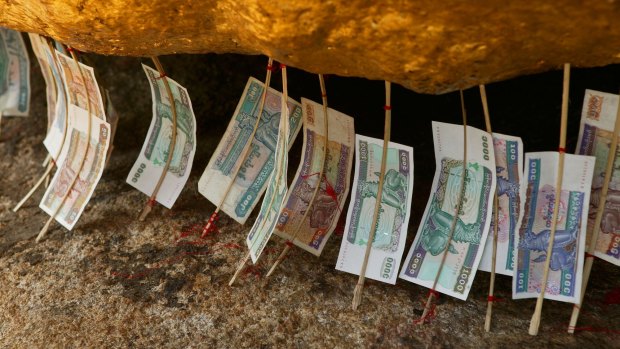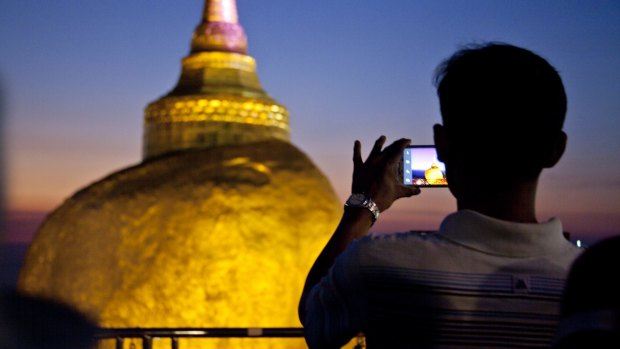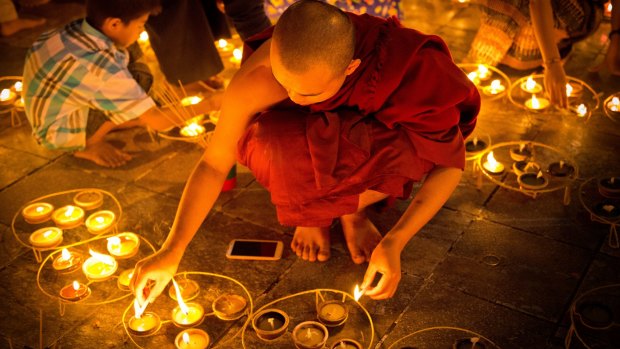This was published 8 years ago
Golden Rock, Myanmar: Asia's mysterious giant rock defying the rules of gravity

Kyaiktiyo Pagoda also called the Golden Rock in Myanmar. Credit: Alamy
There are times when you travel when your preconceptions of an event or place and the reality are so far removed it can blow your mind. This is one of those times.
I'd pictured Golden Rock as a sedate site of reverence, a smattering of travellers, a few dozen monks praying silently beside candles flickering in the twilight. It's safe to say I may have underestimated things.
At the top of a mountain path, where a clearing has just opened up, enough people to fill a football stadium swarm a vast tiled square like frenzied ants around their nest. Aside from a few western faces, most are locals, many of them Buddhist monks of all ages, their saffron robes resplendent in the evening light.

Money offerings at Golden Rock.Credit: Alamy
On the far side, perched precariously on the edge of a cliff stands the rock itself; a giant, gravity-defying monolith plastered in so much gold leaf it looks like a prop from a 1950s sci-fi film.
Golden Rock, or Kyaiktiyo Pagoda as it's also known, is a sacred pilgrimage site in Mon State, some 200 kilometres northeast of Yangon. Crowned by a pagoda, it's situated at the top of Mt Kyaiktiyo and looks by all accounts as though it may tumble down the mountainside at any moment should someone sneeze in its general direction.
Legend has it the rock maintains its unlikely balance thanks to a meticulously placed strand of Buddha hair and whether you buy into this folklore or not, it is undeniably a freak of geography.

Golden Rock.Credit: Guy Wilkinson
For most pilgrims, coming here would have been a dream for many years and the arduous journey up the mountain is seen as an integral part of the experience. From Kin Pun – a hub of shops and hotels serving as base camp – it's a steep 11 kilometre uphill march to get to this point.
But like the majority of travellers, I instead opted to get here via a white-knuckle ride on an open top truck. These hydraulic powered beasts carry up to 40 people on simple wooden benches, much like souped up double-decker buses. Navigating a series of hairpin bends on a partially cemented road, they are as close to being on a rollercoaster, without actually being on a rollercoaster as you're ever likely to come. From the drop-off point, it's then only a ten-minute up hill stroll to the main attraction.
With the sky transitioning from streaky bacon to cobalt blue and then a rich lilac, the rock is beginning to showcase some of its star quality. At over seven metres tall, burning brilliant gold against the fading sun, it has an increasingly surreal quality.

Festival of candles at Golden Rock, Myanmar.Credit: Alamy
Having kicked off my thongs at the base of the hill – as custom demands – I wander the square taking in the scene, enjoying the feel of the tiles beneath my feet, still baked warm from the afternoon sun. In the far corner, a row of shops sell soft drinks, fruits and candles, a Buddhist convenience mall of sorts, though most visitors appear to have come prepared.
People carrying wicker baskets on their heads zigzag around me in all directions, groups gather on straw mats, there's an almost festival air, like the Glastonbury of Buddhism, only the thumping tunes and pints of lager have been replaced by josticks and pious devotion.
The whole spectacle is a model of tradition; a throwback to earlier times seldom seen in the modern world.
But there are more unexpected sights, as bemusing as they are surprising. Everywhere I look, monks are taking selfies on smart phones or iPads or posing for photos before the rock in huddled groups like a football team that's just bagged a major trophy.
It's a strange juxtaposition I notice throughout my time Myanmar, which until recently was the world's second most isolated nation. Slowly, somewhat insidiously, it appears the modern world is creeping in.
Selfie sticks and iPads aside, there is a tranquil air to the proceedings. In spite of the vast crowds, people are anything but aggressive, eye contact is invariably met with a smile or a shy laugh, there's no argy bargy or mindless shoving as you might encounter in other places.
With night settling in, the action around the shrine intensifies. Crowds congregate to light josticks and candles; soon the air is thick with the smell incense, hundreds of tiny flames winking in the darkness.
It's late but the temperature is still warm. With the average price of a hotel room beyond the reach of most that live here, many will hunker down in swags or sleeping bags, or simply make do with a straw mat and a blanket on the tiled floor.
Part of me would genuinely relish sleeping out beneath the stars, but there are plenty of hotels in the area and we opt to stay at the Mountaintop, a plush, cliff edge property ten minutes stroll downhill from the main square.
It may not be the truest path to enlightenment, but a cold beer and a hot shower certainly feel like Nirvana at this point.
It's still dark when we reconvene at five the next morning to watch the sunrise over the rock. Outside the hotel there is already a steady flow of people heading downhill to make an early getaway.
Hundreds of metres below us, a thick blanket of cloud rolls out towards the horizon above the surrounding jungle canopy.
Weaving between the throng, it's hard to ignore the hermits, stood motionless in the centre of the street at periodic intervals. They're dressed in brown robes, sporting what resemble elongated pirates' hats; carrying wooden beams over their shoulders, a bucket attached to each end. Scowling, gazing intently into the middle distance, they strike simple triangular bells, waiting patiently for donations.
Hermits once lived in the forests, but nowadays they reside mostly in monasteries. Much like monks, but with a slightly more enigmatic air, they practice meditation but not Buddhist rituals.
Back at the main square, the sun now burns a blistering pink through the morning haze. At a shrine near the rock, there is something of a morning after feel; rows of melted candles, piles of trays containing the remnants of last night's offerings; sliced watermelons and oranges, bowls of rice and plastic cups scattered everywhere, like a children's party where everyone had way too much sugar. Within a few hours, everything will be swept away and the cycle will repeat itself.
On the way back down to meet the trucks, I head along a narrow stone path cutting through the side of the mountain back towards Kin Pun.
Near the hillside, stalls sell Cobra heads, sheep skulls and centipedes in jars of liquid, all said to have healing qualities helpful to soothing muscular aches and pains.
A family sits in tarpaulin shack with a corrugated iron roof watching bubble a back TV, the father in a deckchair, his kids spread out across the floor. Just opposite, a woman has set up a makeshift kitchen on a stone bench top. Blowing gently against a pile of smoking twigs, she catches a spark, placing a heavy cast iron pot on a circle of rocks surrounding the flame.
It may be chaos back up the hill but simple village life continues here, just another day living on the mountain.
When the road opens out, we're followed by a procession of monks walking silently in single file. They stop occasionally at local stores where the proprietors fill their bowls with scoops of rice, an offering to ensure good karma, a commodity worth its weight in gold, let alone rice.
Further down, the truck is waiting. Clambering aboard, the engine fires to life as we brace ourselves for the inevitable ups and downs, twists and turns.
Much like any good Buddhist pilgrim living in modern day Myanmar.
FIVE MORE ESSENTIAL MYANMAR HIGHLIGHTS
1 SHWEDAGON PAGODA The 2500-year-old gilded masterpiece is among the most important sacred Buddhist sites in South East Asia. Surrounded by colourful temples and stupas, the central 110 metre high pagoda is crowned by 4531 diamonds. See theshwedagonpagoda.com
2 TEMPLES OF BAGAN Another pilgrimage site of great significance, more than 2000 temples are scattered across the plains of Bagan. You can explore them by foot, bike or even hot air balloon. See baganmyanmar.com
3 MAWLAMYINE Situated at the mouth of the Thanlwin River, the country's fourth largest city contains some of the best-preserved colonial architecture in Myanmar and is a launch pad to explore nearby tropical islands and cave systems. See mawlamyine.com
4 INLE LAKE Sitting in a valley between two mountain ranges, the lake offers insights into the way of life of the Intha people where stilt houses, floating markets and cottage industries thrive in a unique environment. See hinlelake-myanmar.com
5 MYEIK ARCHIPELAGO Still regarded as one of the last frontiers in South East Asia, this spectacular cluster of more than 800 islands offers outstanding diving amid pristine coral reefs. See go-myanmar.com/the-myeik-archipelago
TRIP NOTES
MORE INFORMATION
GETTING THERE
Thai airways fly direct from Sydney to Bangkok with convenient ongoing connections to Yangon, see thaiairways.com
TOURING THERE
The Intrepid Travel 14-day Burma to Thailand trip travels south from Yangon to Bangkok taking in Golden Rock. From AU$2400. See www.intrepidtravel.com
The writer was a guest of Intrepid Travel and ASEAN (Association of South East Asian Nations), which Myanmar is a part of.
Sign up for the Traveller Deals newsletter
Get exclusive travel deals delivered straight to your inbox. Sign up now.